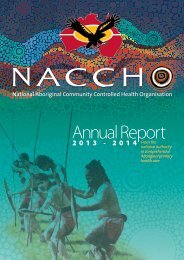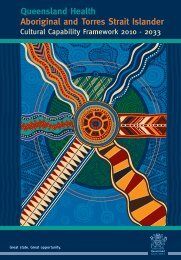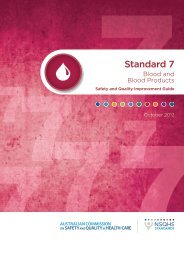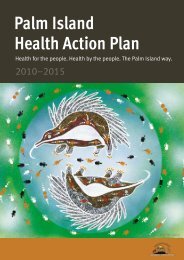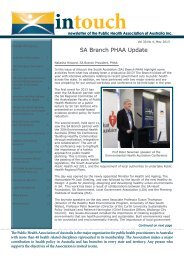CLOSING THE GAP
ctg-report-2017
ctg-report-2017
You also want an ePaper? Increase the reach of your titles
YUMPU automatically turns print PDFs into web optimized ePapers that Google loves.
Tobacco use is one of the leading causes of preventable<br />
disease and premature death in Australia. While smoking<br />
rates have continued to decline in Australia, the smoking<br />
rates of Indigenous Australians aged 15 and over are<br />
significantly higher than the broader population.<br />
The Tackling Indigenous Smoking program funds<br />
37 regional grants to deliver best practice tobacco<br />
control approaches. Local community activities<br />
promote the benefits of not smoking, improve<br />
access to support and build capacity of individuals<br />
and organisations. National supports include<br />
funding to enhance Quitline services for Aboriginal<br />
and Torres Strait Islander callers, training in brief<br />
interventions and a National Best Practice Unit.<br />
The program also funds seven innovation grants,<br />
targeting critical smoking behaviours within<br />
Aboriginal and Torres Strait Islander communities,<br />
particularly pregnant women and young people<br />
in remote communities. These grants deliver<br />
intensive smoking prevention and cessation<br />
activities, coupled with research and evaluation.<br />
Tackling Ice<br />
Under the National Ice Action Strategy, we have<br />
committed almost $300 million over four years<br />
from July 2016 towards a number of measures to<br />
reduce the impacts associated with drug and alcohol<br />
misuse to individuals, families and communities.<br />
This funding will strengthen education, prevention,<br />
treatment, support and community engagement. Of<br />
this total investment, $78.6 million over four years is<br />
being provided for PHNs to commission Indigenousspecific<br />
drug and alcohol treatment services.<br />
Reducing petrol sniffing<br />
In some remote communities, petrol sniffing was<br />
having a significant impact on the health and wellbeing<br />
of individuals, families and communities. This led to<br />
communities and governments working together to<br />
develop a solution. Low aromatic fuel (known as Opal<br />
at the time) was first made available in communities in<br />
Central Australia and Western Australia in 2005 and<br />
has been highly successful in reducing rates of petrol<br />
sniffing. The availability of the fuel has grown and it is<br />
now available in more than 170 fuel outlets in regional<br />
and remote parts of Australia. The tenth anniversary<br />
of low aromatic fuel being available in fuel outlets<br />
in Alice Springs was celebrated in October 2016.<br />
Research released in 2016 from the Menzies School<br />
of Health Research found that, in communities<br />
surveyed since 2005-07, petrol sniffing has reduced<br />
by up to 88 per cent since the introduction of low<br />
aromatic fuel (d'Abbs & Shaw, 2016). This research<br />
also found a 90 per cent reduction in the number of<br />
people sniffing at least once week and who are most<br />
at risk of potentially irreversible physical harm.<br />
BUILDING <strong>THE</strong> EVIDENCE<br />
Tackling Indigenous Smoking program<br />
The Tackling Indigenous Smoking program is a targeted<br />
investment to reduce smoking rates in the Indigenous<br />
population. Innovation grants funded under the program<br />
will build evidence on reducing smoking in hard to<br />
reach groups, with a focus on intensive interventions for<br />
pregnant women, for remote communities, and for youth<br />
in remote areas. The program also includes a National<br />
Best Practice Unit that facilitates implementation of<br />
best practice Indigenous tobacco control by regional<br />
grant recipients and promotes research, monitoring<br />
and evaluation of evidence-based models for tobacco<br />
control, including through the Tackling Indigenous<br />
Smoking portal on the Australian Indigenous Alcohol and<br />
Other Drugs Centre website. A full program evaluation<br />
is underway and is due for completion in mid-2018.<br />
School nutrition projects<br />
The Menzies School of Health Research is reviewing<br />
school nutrition projects to determine their nutritional<br />
contribution, measure the extent to which school<br />
nutrition projects comply with relevant dietary guidelines<br />
and explore the importance of the school nutrition<br />
projects in providing for children’s nutrition needs. This<br />
review is expected to be completed in June 2017.<br />
National Disability Research and<br />
Development Agenda<br />
The National Disability Research and Development<br />
Agenda includes projects with a specific focus on<br />
Aboriginal and Torres Strait Islander people with<br />
disability. These research projects, which are currently<br />
underway, aim to support Indigenous people to<br />
live and stay on country, undertake Indigenous-led<br />
disability research, improve education and employment<br />
outcomes through digital enterprise, and address legal<br />
barriers for Indigenous Australians with a disability.<br />
Suicide Prevention Centre of<br />
Best Practice<br />
A National Centre of Best Practice in Aboriginal<br />
and Torres Strait Islander Suicide Prevention<br />
will be established to provide best practice<br />
information and advice, building the capacities<br />
of Primary Health Networks and Indigenous<br />
communities to take action in response to suicide<br />
and self-harm in their immediate region.<br />
•88• <strong>CLOSING</strong> <strong>THE</strong> <strong>GAP</strong>: PRIME MINISTER'S REPORT 2017



